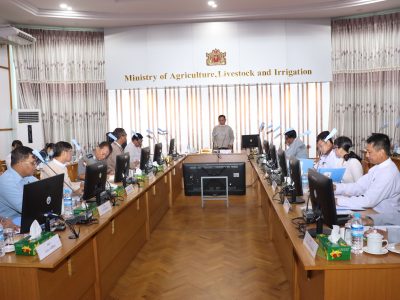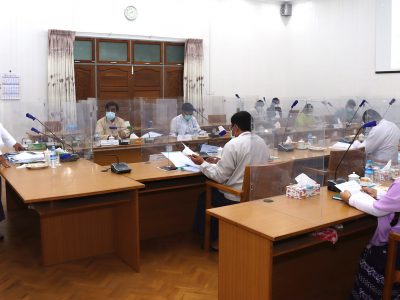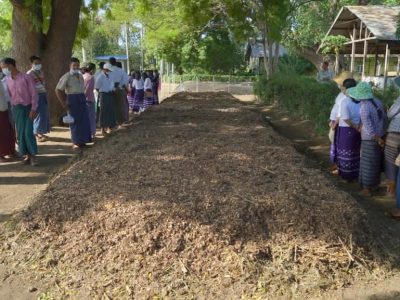Because of the need to feed and clothe the increasing human population, agricultural production has been increasing worldwide. This increased agricultural production would not be possible without the increased input of plant available nitrogen. The use of synthetic fertilizer increased from near zero six decades ago to about 450 million tons annually today. However, the nitrogen added is not used efficiently and large losses can occur (Frenery, 2011). Much oflossesoccur in the form of nitrous oxide (N2O)emissionsthrough biological nitrification and de-nitrification processes, ammonia volatilization especially in alkaline conditions, leaching where rainfall exceeds evapotranspiration, and run-off. It was estimated that the inefficiencies and overuse of synthetic fertilizer in the agricultural systems of some GMS countries cause as much as 18% of global N2O produced by the fertilizers that enters the atmosphere. Nitrous oxide is an important long-lived greenhouse gases and its atmospheric life-time is 120 years. It has heat-trapping ability 289 times greater than that of carbon dioxide. Thus, the governments of the Greater Mekong Sub-region (GMS) are increasingly concerned about the risks posed by rising and inefficientuse of synthetic nitrogen fertilizers and its impact on climate change as well as on soil, water, and the environment. To reduce the impact of N2O emission from agricultural sector, it needs to manage the application of fertilizer nitrogen very efficiently. Thus, the “Improving the Efficiency of Nitrogen Cycle Management in the GMS” project has been proposed.
The project is being implemented under ADB TA 8163 REG: Implementing the GMS Core Agriculture Support Program Phase 2 (CASP 2) and funded by ADB, Government of Sweden (Sida), Nordic Development Fund (NDF) and Water Finance Partnership Facility (WFPF), Switzerland. It is a short term technical support, research and demonstration project. The focal implementing partner in Myanmar is DoA. The DoA has acquired the guidance by NSSU and technical supportby NIRAS’ expert at Working Group on Agricultural Secretariat in Bangkok in the implementation of LoA activities.
Under the output 3 of CASP 2: Increased adoption of gender-responsive and climate friendly agriculture, the Nitrogen Use Efficiency (NUE) Management project focuses on integrated nutrient management system to mitigate nitrogen nutrient losses due to N2O emission in crop production through improving the efficiency of nitrogen cycle management. Furthermore, it also focussesonimproving crop productivity and enhancingmarket access for NUE farmers.
The project has been implemented in two regions such as Dakhinathiri, and Pokebathiri Township in Nay Pyi Taw and Shwebo Township in Saggaing Region. Firstly, the project conducted preliminary survey to understand the current status of nutrient management practices and gender issues on decision-making process,gender roles and gender needs in farming system of targeted regions. To disseminate knowledge regarding potential economic benefit through efficient nitrogen management practices, twenty model demonstration farms (at least 20% women managed model farms) for rice crop and 30 demonstration farms (at least 20% women managed model farms) for maize were conducted in those two regions. These demonstration farms will be linked to market network. To promote the market access, contract-farming system was developed in collaboration with the private sector under the project. Among the 50 model demonstration farms, 2 model farms for rice crop and 2 model farms for maize crop have been selected to be experimental sites and established to become the long-term model farms on NUE. In addition, in order to prove how integrated nitrogen nutrient management improve nitrogen use efficiency of crop and reduce nitrous oxide emission from rice field, practical field measurement of nitrous oxide in rice field was conducted. To strengthenknowledge of climate friendly agriculture and efficient nitrogen management practices to improve nitrogen use efficiency incropping, training to trainers, training to farmersand exchange visitsare also included in the project’s activities. From the findings and achievement of preliminary survey, research, field days and exchange visit relating to nitrogen fertilizer management issues, plus a policy study and national dialogue, the recommendations for policy support to promote NUE will be identified and submitted to MOALI for endorsement.
| ADB Regional Technical Assistance | RETA 8163 |
| Project Title | Improving the Efficiency of Nitrogen Cycle Management in Rice and Maize Cropping Systems in the Central Myanmar |
| Executing Agencies | Working Group on Agriculture Secretariat (WGA-S) |
| Implementing Agencies | MAFF/GWS/WGA-NSSU |
| Implementing Partners | Department of Agriculture (DoA) |
| Total Project Cost | 100,000 USD |
| Project Financing | ADB, SIDA, NDF and WFPF
TA 8163: |
| Date of LOA-NUE Approval | June 2017 |
| Date of Signing of Contract | 20 July 2017 (ADB side) and 17 October 2017 (DOA side, for processing internal approval) |
| Date of Effectiveness of LOA-NUE | June 2017 |
| Closing Date of LOA-NUE | February 2018 (request for an extension for the project to end on May 31, 2018 is being processed) |
| Date and Amount of Disbursement | First disbursement:
|
| Amount Utilized (As of December 2017): | $30,457 |
| Project Outcome | Crop productivity, production and income of small holder farmers improved through promotion of Nitrogen Use Efficiency (NUE) technologies |
| Project Outputs | – Output 1. Capacity of extension staffs and small holder farmers to apply NUE technologies improved and knowledge of market linkage developed
– Output 2. NUE experimental plots conducted and maintained as long-term NUE model/demonstration plots – Output 3. NUE technology adopted and expanded to more farmers in the project sites – Output 4. Access to market for NUE products established – Output 5. Knowledge products on NUE produced, shared and disseminated – Output 6. Policy recommendations on NUE produced and endorsed by MOALI |
| Project Area | The Project covers 3 villages, 1 township of Sagaing Region and 3 villages,3 townships of Nay Pyi Taw.
Direct target beneficiaries are 300 small holder farmers and 50 government officials. |
It is expected that the project’s introduced best Nitrogen (N2) management practice by applying chemical nitrogen fertilizer together with biochar and other organic sources will: l) increasenumber of NUE farms by 30%; of which, 30% are managed by female farmers; 2) increase yield of NUEfarms by 15% compared to conventional practices; 3) increase nitrogen fertilizer use efficiency by 30% which result in an increased income of 20 % for crops/land benefiting from NUE. Results by the end of February 2018 (or by end of project) will be compared with the baseline estimates madeearly 2017, prior to the start of the project.
There are 6 main outputs with 12 indicators to be achieved, by the end of project as shown in Table 1.
Table 1. Outputs Indicators and Targets
| Indicator | Target |
| Output1: Capacity of extension staff and small holder farmers to apply CSA technologies improved and knowledge of market linkage developed | (1) At least 300 farmers and 200 of government staffs (30% women) will be trained on NUE technologies. Among them a total of 50 officers will be selected for training to become trainers in NUE techniques.
(2) 100% of trained farmers applied appropriate NUE practices in their farms. (3) At least 30% of trained farmers could negotiate for contract initiation, discuss and bargain prices with traders |
| Output 2: NUE experimental plots conducted and maintained as long-term NUE model/demonstration plots | (4) At least 4 NUE model farms established and functioned
(5) At least 10% of N2O gas emission from NUE farms reduced |
| Output 3:
NUE technology adopted and expanded to more farmers in the project sites |
(6)At least 50 new farms that applied NUE technologies fully established as pilot farms
(7) At least 2 pilot projects involving 50 pilot farmers (30% women-managed farms) adopted NUE practices and linked to market through collaboration with the private sector. |
| Output 4:
Access to market for NUE products established |
(8) At least 30% of NUE farmers in project sites (30% women) signed contract farming with private enterprises (baseline 0) |
| Output 5: Knowledge products on NUE produced, shared and disseminated | (9) Number of NUE knowledge products produced and distributed to farmers (1,000 pamphlets, 100 posters and vinyls)
(10) At least 35% of farmers applied NUE techniques learned from knowledge products which distributed by the NUE project |
| Output 6:
Policy recommendations on NUE produced and endorsed by MOALI |
(11) One policy assessment report completed
(12) At least 2 policy recommendations submitted to national policy makers endorsed by MOALI |
Project Immediate Outcome:
As the Project commenced in October 2017, the achievement of project outcome cannot be seen yet. However, NUE farmers have got knowledgeon how to effectively utilize by-products of milling rice such as rice husk through making biochar instead of burning. Farmers realize that leaf colors of plants consistently show green color under the application of chemical fertilizers together with organic sources. Achievement of specific stated outcome will be assessed and discussed in the next progress report.
နှစ်အလိုက် ဆောင်ရွက်ပြီးစီးမှု အခြေအနေ






